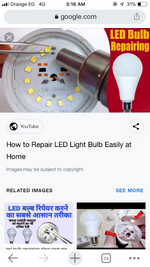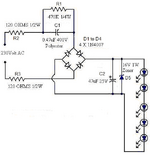Gaber Mohamed Boraey
Full Member level 2
Hello everyone
The article maybe appear as simple , but I am just curious to know
We all have led lamps at home these days, and it all stop lighting suddenly
I’ve tried to repair different ways, of course it’s cheap to buy a new one, but I just tried repair because I had many, and had the tools for repair,
But sadly, all the different ways I’ve used failed, or in other words, repaired the lamp but for few hours
I’ve tried jumper at place of dead led in the led circuit, also tried silicon doide at the place of dead led, also different resistors, didn’t calculate just tried 1k Ohm 1ohm
Asking experts here, is it really possible to repair led lamp, and last for more time , for ex. Few months?, or when led burn it’s the start of led life end?, and repair not good idea?
If repair possible, what the right way for repair except changing the burning led with new one, as I think hardly get smd leds my country
Attached photos for burned led in lamp
The article maybe appear as simple , but I am just curious to know
We all have led lamps at home these days, and it all stop lighting suddenly
I’ve tried to repair different ways, of course it’s cheap to buy a new one, but I just tried repair because I had many, and had the tools for repair,
But sadly, all the different ways I’ve used failed, or in other words, repaired the lamp but for few hours
I’ve tried jumper at place of dead led in the led circuit, also tried silicon doide at the place of dead led, also different resistors, didn’t calculate just tried 1k Ohm 1ohm
Asking experts here, is it really possible to repair led lamp, and last for more time , for ex. Few months?, or when led burn it’s the start of led life end?, and repair not good idea?
If repair possible, what the right way for repair except changing the burning led with new one, as I think hardly get smd leds my country
Attached photos for burned led in lamp

